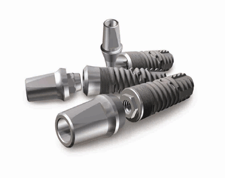المقالات
Implant Bridge

Restoring your mouth with implants and a dental bridge is accomplished in two phases. The first phase of the procedure is the surgical placement of the implants. They're under the gums for several months while the bone attaches to them. After healing, the second phase begins. The implants are re-exposed and your new teeth are made.
For the surgical placement of the implants, your mouth will be thoroughly numbed. Incisions are made in your gums and channels are made in the bone to receive the implants. After the implants are snugly in place, the gums are closed over each implant with a stitch or two. Over the course of the next few months, the implants become securely attached to the bone
The second phase starts with surgical exposure of the implants. Incisions are made in your gums and small extensions are placed to bring them above the gum line. We then start a series of appointments to make your new bridge. Though some of the steps might be different in your case, they usually include making impressions of your mouth. From these impressions, we make precise working models of your mouth, which are carefully mounted for proper alignment. It's on these models that your bridge is fabricated.
The last step is the placement of the bridge. The success of your implants then depends on your care of the implants at home, and our support through regular checkups and cleanings here in our office.
Placing a bridge after teeth have been lost can prevent a chain reaction of problems that could affect your entire mouth. Teeth need each other for support, and when a tooth is lost, the biting forces change on the teeth next to the space, causing them to shift. When a tooth on the opposite arch no longer has anything to chew against, it begins to extrude out of the socket. You can eventually end up losing it too.
As your bite changes, it gets harder and harder to chew your food and your jaw joint, the TMJ, may be damaged. It's also much harder to clean teeth that have shifted. Harmful plaque and tartar collect in these new hard-to-reach places, causing cavities and the permanent bone loss that comes with gum disease.
Dental implants are small titanium cylinders that are surgically inserted into the bone of the jaw to replace the roots of missing teeth. Artificial teeth are then attached to the implants, and can be used as part of a bridge.
A partial denture is another way to solve the problem of missing teeth, but there are several advantages to an implant-supported bridge. You avoid the clasps and metal work that come with a partial denture, and an implant can help stop the continuing bone loss that begins when teeth are removed. Using dental implants to support a bridge is an excellent way to replace missing teeth.
